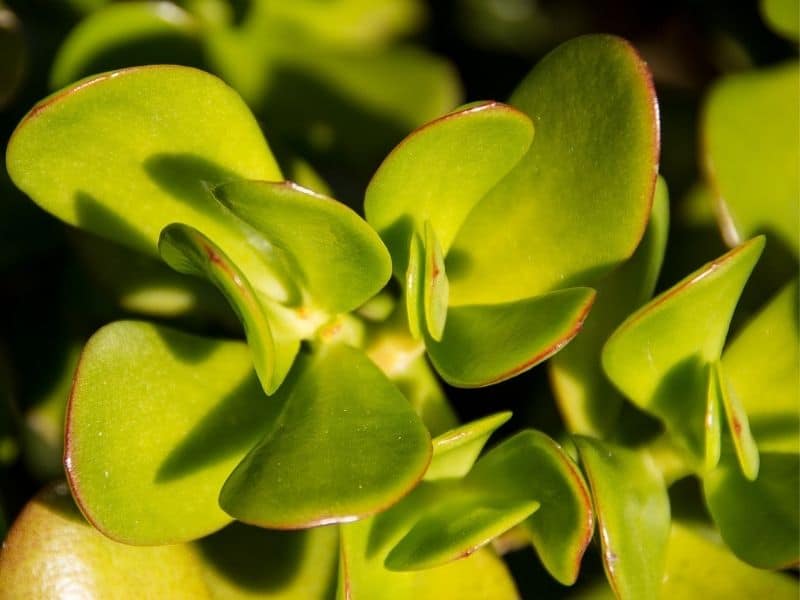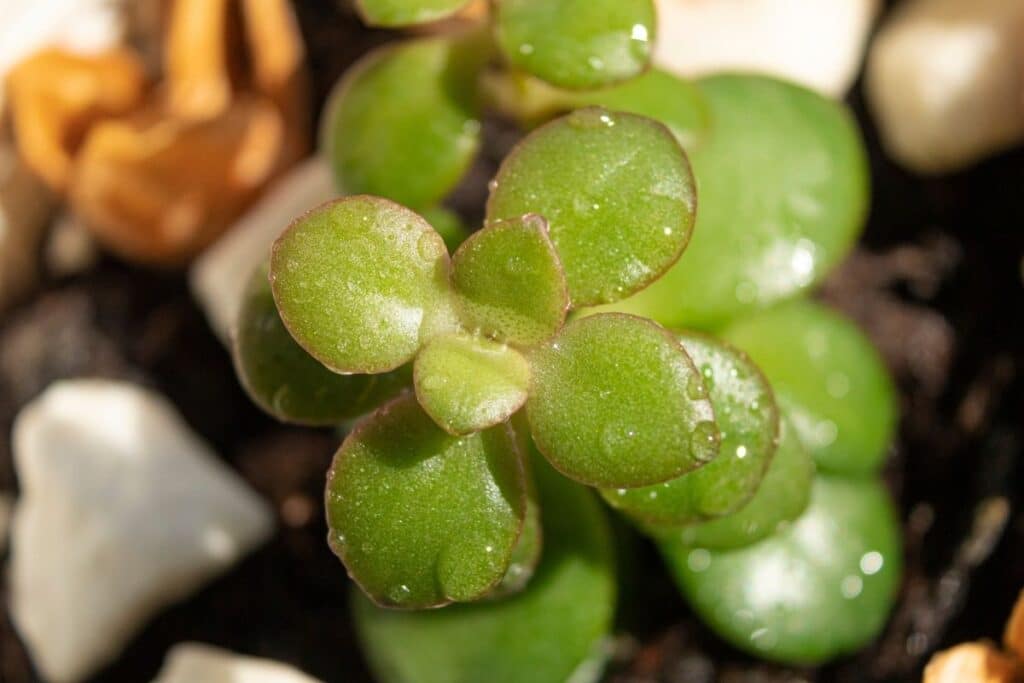With its large collection of varied but equally beautiful succulents, Crassula has become one of the staple plants for many cactus and succulent collections. But with its many varieties, choosing the perfect plant and meeting its growth requirements may become quite a challenge.
- What is a Crassula Plant?
- How to Grow and Care for Crassula Plants
- What Are The Best Types of Crassula to Plant?
- Crassula alstonii
- Crassula ‘Buddhist’s Temple'
- Crassula columnaris
- Crassula cornuta
- Crassula cotyledonis
- Crassula 'Devil's Horns'
- Crassula falcata (Propeller Plant)
- Crassula muscosa (Watch Chain)
- Crassula pellucida 'Variegata' (Calico Kitten Crassula)
- Crassula perforata (String of Buttons)
- Crassula exilis subsp. picturata (Tiger Jade)
- Crassula pyramidalis (Pagoda Mini Jade)
- Crassula rubricaulis (Candy Cane)
- Crassula rupestris ssp (Rosary Vine)
- Crassula 'Surprise Party'
- Crassula ausensis ssp
- Crassula capitella ssp
- Crassula ciliata
- Crassula sarcocaulis
- FAQs
Read on to see the best types of crassula to choose from and learn how to care for them.
What is a Crassula Plant?

Crassula is an extensive genus of succulent plants from the stonecrop family (Crassulaceae). With over 200 species, these plants can be found all over the world but most of the cultivated varieties are almost exclusively from species native to South Africa (1).
Crassula plants are a staple for many cactus and succulent collections. Depending on the variety, crassula plants can exhibit either a branching or a stacking habit.
Branching crassula is similar to jade plants (Crassula ovata). They develop thick fleshy stems and grow into branching shrubs with widely spaced leaves. Stacking crassula, on the other hand, are low growing plants, often miniature, with tightly packed leaves growing along a thin, pendant stem (1, 2).

The name Crassula is an allusion to the plant’s thick, fleshy leaves which grows in varied shapes, colors, and patterns. The varying leaf forms of crassula plants are what attract many collectors and not the flowers. But that does not mean that these plants have unattractive blooms.
In fact, the flowers of crassula plants are very showy. These crassula succulents grow in a cyme inflorescence with colors ranging from striking red and yellow, to delicate cream white and pink (1, 3).
How to Grow and Care for Crassula Plants
The requirements for a healthy crassula will differ from one species to another. Generally, these plants are low maintenance, but some varieties may have some special needs in order to thrive beautifully. Give your crassula plants some tender love and care with some of these caring tips.
How much light do Crassula plants need?
Crassula plants need bright light to attain vibrant leaf colors, but the full sun can scald their succulent leaves. Prevent this from happening by placing your crassula in partial shade where they can still receive lots of bright light.
When growing crassula outdoors, secure a spot where they can receive lots of the gentle morning light and be safe from the harsh afternoon sun. When indoors, place your crassula next to a window where they can get lots of bright indirect light (4).
How often should you water Crassula plants?
The watering needs of crassula plants will depend on the conditions in your area. Generally, they require sparse watering. Keep the soil dry or moist but not soggy to prevent the roots from developing root rot.
As a rule, for succulents, allow the topsoil to become dry to the touch before the next watering. Crassula plants will need frequent watering, especially during hot weather months. In winter, reduce or completely hold off watering to prevent the roots from freezing up and dying (4).
It is important that you do not water crassula plants overhead as the water droplets can cause the leaves to brown when they get exposed to the sun.
What is the optimum temperature and humidity for Crassula plants?
Crassula plants have different hardiness depending on the species. Some species can tolerate mild frosts or hot temperatures. Extreme temperatures and high humidity can cause the leaves to fall off and die. For best growth, crassula plants require mild temperatures with low humidity (4).
What is the best potting/growing media for Crassula plants?
In the wild, crassula plants grow in sandy or rocky ground. Imitate this natural environment by using a porous, well-draining, and organic-rich potting media (4). A commercial cactus/succulent potting mix can be used but if you want to create your own potting mix, simply combine 3:3:1 parts sand, garden soil, and perlite or pumice.
Do Crassula plants need fertilizer?
Crassula plants will need feeding to achieve vibrant colored leaves. Feed your crassula from spring to fall with a soluble balanced fertilizer diluted to half the recommended strength. Do not feed in winter as your crassula will be dormant at this time (5).
Propagating Crassula Plants

Crassula plants are easily propagated through stem cuttings or leaf cuttings. To do so, cut a healthy leaf or healthy stem with several leaf nodes using a clean knife. Place your cuttings in a clean, dry place and let it form a callous and roots.
Once your cuttings have rooted, you can plant them in its regular potting mix and water regularly. Propagation is best done in the growing season (spring-summer).
See more: How to grow succulents from leaves
What Are The Best Types of Crassula to Plant?

With over 200 species to choose from, getting a crassula can become quite a challenge, because let us face it, we only want the best for our collections. But you do not need to worry about it anymore because we have compiled some of the best crassula plants for you!
Crassula alstonii
This miniature crassula features fleshy succulent leaves arranged in a tight velvety dome. Each dome is about 2 to 5 cm in diameter. From October to November, bright yellow flowers poke out from the top of the dome.
Crassula ‘Buddhist’s Temple’
This crassula variety features eye-catching rosette leaves folded up at the edge and stacked tightly forming perfect square-shaped columns like a Buddhist’s Temple. Each column can grow up to 15 inches. In spring and summer, pink and white flowers appear at the top of the columns.
Crassula columnaris
This miniature crassula grows up to an adorable 4-inch erect plant. The short columns are made of 8 to 10 tightly packed green and copper-colored leaves. It may take years but come winter when it’s fully mature, this cute, little succulent will form a pom-pom-like cluster of pale-yellow flowers at the top of the column.
Sadly though, they will die after flowering but do not worry because new pups will sprout and continue its adorable lifecycle.
Crassula cornuta
Another small crassula, C. cornuta features fleshy, velvety grey-green, and pointed leaves tightly packed to form a column. They can grow up to 6 inches in height and bloom in winter into starry creamy white and pink flowers.
Crassula cotyledonis
This simple crassula features paddle-shaped leaves forming a rosette. The leaves are blue-green in color and have a velvety texture. They are low growing, perfect as tabletop houseplants. From spring to summer, you can see cream and green colored flowers poking out from the center of the rosette.
Crassula ‘Devil’s Horns’
Despite its sinister name, this crassula is quite interesting and somehow graceful. This variety has long pointed leaves that grow in a sprawling rosette. When placed in full sun, the leaves blush a bright red color at the tips.
Crassula falcata (Propeller Plant)
As you can guess from its name, this plant has a resemblance to a plane’s propeller. The grey-green leaves are long and wide growing horizontally from the central stem. Wait until summer and you can see bright orange flowers that smell like cinnamon poking at the center of the propeller leaves.
Crassula muscosa (Watch Chain)
Much like an actual watch chain, this variety has tightly packed, interlocking, small light green leaves. It has a branching habit and can be used as a small-scale ground cover, or as hanging plants. From spring to mid-summer, small, musty smelling, pale yellow flowers bloom from in between the interlocking leaves.
Crassula pellucida ‘Variegata’ (Calico Kitten Crassula)
This pretty little succulent is a sprawling variety, perfect as hanging plants. It features heart-shaped leaves with rosy pink, cream white, and green markings.
Crassula perforata (String of Buttons)
This fast-growing and easy to care for variety are also perfect for hanging baskets. They are small and erect at first but will eventually develop into a sprawling mess of stacked, triangular leaves that look like tiny plump buttons on a string.
Crassula exilis subsp. picturata (Tiger Jade)
If you are looking for something more exotic-looking, this variety is perfect for you. It has triangular leaves that are dark green in color with black markings. Each leaf has a velvety feel to it and when you turn it over, a deep purple underside will surprise you.
Crassula pyramidalis (Pagoda Mini Jade)
This small variety has sparingly branched erect stems and can grow to about 6 inches tall. Tightly packed triangular copper and green colored leaves form a column that resembles a Japanese pagoda tower. To add to its oriental look, these plants will develop a red tinge when in full sun.
Crassula rubricaulis (Candy Cane)
This chimaeric variety of crassula features leaves with green and cream stripes. When in bright sunlight, you can get three colors as your plant takes on a pinkish hue.
Crassula rupestris ssp (Rosary Vine)

Rosary vines form succulent shrubs with spreading branches. The leaves can be Grey-green with mint margins or orange with yellow/red margins when exposed to full sun.
Each leaf is oval with a pointed tip, growing in alternating rows along the fleshy branches. From winter through spring, white and pink flowers bloom from the end of each branch.
Crassula ‘Surprise Party’
These are a curious-looking variety of crassula. They have long pointed leaves surrounded with soft, bristle-like hairs which give the plant a fuzzy, frosted look.
Crassula ausensis ssp
Crassula ausensis ssp. titanopsis is a captivating succulent plant belonging to the Crassulaceae family, native to the rocky slopes of South Africa.
Renowned for its distinctive rosettes of thick, triangular leaves, adorned with intriguing patterns and textures, it adds unique charm to desert gardens and succulent collections.
Crassula capitella ssp
Crassula capitella subsp. thyrsiflora, commonly known as Red Pagoda or Pyramid Plant, is a captivating succulent. As it matures, it reaches a height of up to 20 cm (8 inches).
The plant’s defining feature is its green leaves adorned with striking red edges. During summer and fall, it produces delicate white flowers.
This unique succulent thrives in full sun, making it an excellent addition to your plant collection. Remember to avoid overwatering and provide well-drained soil for its health. Whether displayed in a beautiful pot indoors or grown outdoors, this little pagoda succulent adds a touch of elegance to any space.
Crassula ciliata
Crassula ciliata, also known as Frill Stonecrop, is a captivating perennial leaf succulent native to South Africa.
This much-branched shrublet grows up to 8 inches (20 cm) tall, with short decumbent branches. Its leaves are pale green, oblong-elliptic, and slightly recurved, forming a dense row. The margins of the leaves are adorned with delicate cilia.
When stressed by direct sun or drought, the leaves develop a reddish flush. In late spring and summer, cream to pale yellow tubular flowers appear in rounded thyrse inflorescences.
Crassula sarcocaulis
Crassula sarcocaulis, also known as the Bonsai Crassula or African Wood Crassula, is a captivating succulent native to South Africa. Its most distinctive feature is its thick, woody stem, which develops a gnarled, bonsai-like appearance over time, making it a favorite among collectors.
This genus crassula produces clusters of small, star-shaped white flowers atop tall stems, adding to its ornamental appeal.
FAQs
How do I identify my Crassula?
Identifying a specific Crassula plant can be challenging without knowing its specific characteristics, such as leaf shape, color, and growth habit. Some common Crassula species include Crassula ovata (Jade plant), Crassula perforata (String of Buttons), and Crassula ovata ‘Gollum’ (Gollum Jade). Consulting plant identification guides, online resources, or seeking assistance from a botanist or horticulturist can help in identifying your Crassula plant accurately.
Is A Crassula a bonsai?
No, Crassula plants are not typically considered bonsai in the traditional sense. While some Crassula species, such as Crassula ovata (Jade plant), can be trained into bonsai-like forms with proper pruning and training techniques, they are not classified as true bonsai.
Is kalanchoe a Crassula?
Kalanchoe and Crassula are both genera within the family Crassulaceae, but they are distinct and separate plant groups. While they share some similarities in appearance and care requirements, they are different plant genera with their own unique characteristics.
References
Reference List:
(1) Hyde, M.A., Wursten, B.T., Ballings, P., Coates Palgrave, M. “Genus page: Crassula“. Flora of Mozambique. 2020
(2) Baldwin D.L. “Succulents Simplified: Growing, Designing, and Crafting with 100 Easy-Care Varieties“. Timber Press. 2013. PP. 203-205
(3) Court D. “Succulent of Southern Africa” CRC Press. 2000 P. 73
(4) Tuttle C. “Succulents“. Penguin. 2015. Part 5.
(5) Pleasant B. “The Complete Houseplant Survival Manual: Essential Gardening Know-how for Keeping (Not Killing!) More Than 160 Indoor Plants“. Storey Publishing. 2012. P. 79
Close
Image by depositphotos.com/[email protected]







